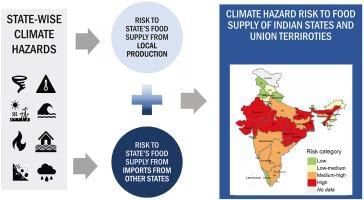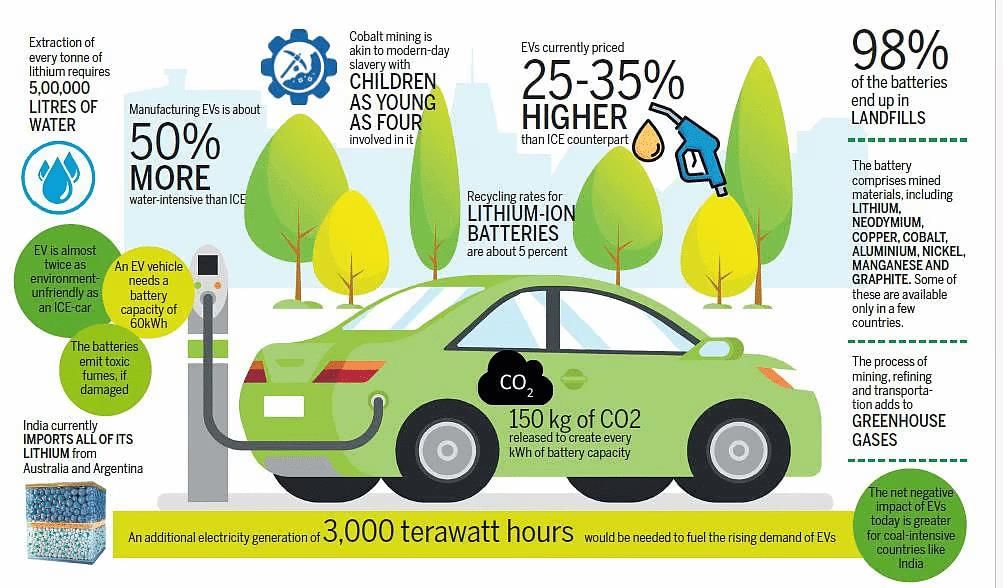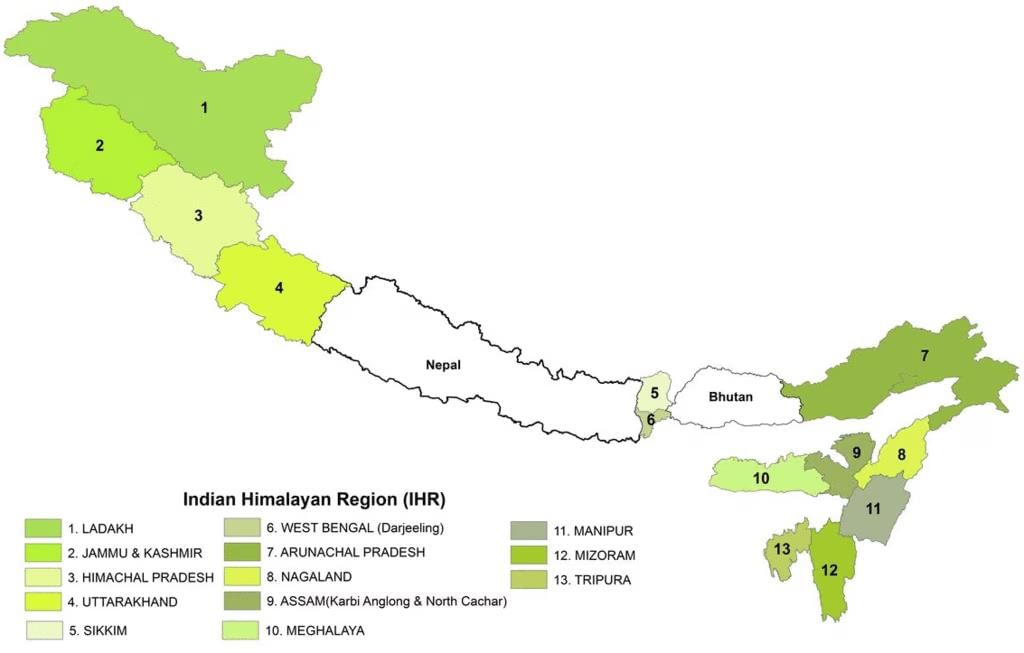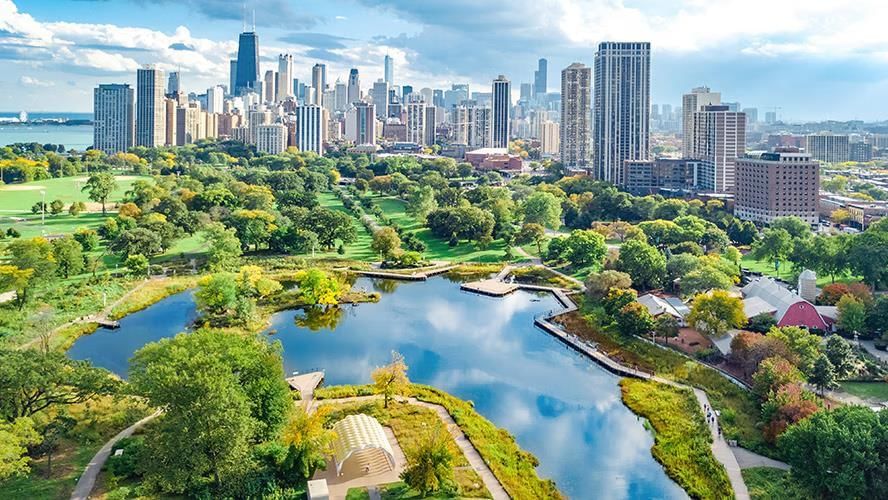Weekly Current Affairs (22nd to 31st May 2025) - 1 | Weekly Current Affairs - UPSC PDF Download
Climate Physical Risks in India
 Why in News?
Why in News?
- Recent reports, including those from the World Bank, highlight India's ongoing climate crisis, with Climate Physical Risks (CPRs) such as rising temperatures, erratic monsoons, and severe disasters threatening over 80% of the population and the economy.
Key Takeaways
- CPRs refer to the direct and indirect impacts of climate change on ecosystems, human societies, and economic systems.
- India faces significant challenges from both acute and chronic physical risks related to climate change.
Additional Details
- What are Climate Physical Risks? CPRs arise from extreme weather events and long-term climatic shifts, leading to financial losses, operational disruptions, and threats to lives and livelihoods.
- Types of CPRs:
- Acute Physical Risks: Short-term, high-impact events like hurricanes, floods, and heatwaves leading to infrastructure damage and loss of life.
- Chronic Physical Risks: Long-term changes like rising sea levels and increasing temperatures that cause reduced agricultural productivity and health risks.
- Impact on India:
- Rising Temperatures: Average temperatures increased by approximately 0.7°C from 1901 to 2018; significant heatwaves could last much longer by 2100.
- Erratic Monsoons: A 27% increase in dry spells was noted from 1981 to 2011, with extreme rainfall events also becoming more frequent.
- Droughts & Water Scarcity: 600 million people face high to extreme water stress, with severe implications for agriculture and economic stability.
- Rising Sea Levels: Projected sea-level rise could impact around 27 million people in India by 2100.
- Food Security Crisis: Climate change may significantly reduce crop yields, affecting nutritional quality and food security.
- Economic & Infrastructure Damage: India has suffered substantial economic losses from climate-induced disasters, including USD 3 billion from floods in the last decade.
- Challenges in Tackling CPRs:
- Dependence on fossil fuels for electricity, with 77% coming from coal.
- Need for significant climate finance to achieve net-zero emissions.
- Technological lags in green technologies due to high import reliance.
- Vulnerability of renewable projects to climate impacts.
- Limited research and development investment in green technologies, hampering innovation.
- Challenges in electric vehicle adoption due to lack of infrastructure.
- Fragmentation in data for CPR assessments affects unified response efforts.
- Strategies to Address CPRs:
- Agricultural Sustainability: Promoting drought-resistant crops and efficient irrigation practices.
- Robust Urbanisation: Implementing climate-resilient building codes and sustainable transport systems.
- Coastal Adaptation: Enhancing coastal resilience through mangrove restoration and climate-resilient ports.
- Decentralized Adaptation: Forming expert climate cells at district levels for tailored solutions.
- Domestic Clean Energy: Fostering local production of clean energy technologies like solar and wind power.
India faces escalating climate risks that threaten its economy and population. While government initiatives are making progress, addressing CPRs requires urgent and unified action. Strengthening green technology investment and decentralizing climate strategies are essential for safeguarding development gains and ensuring a sustainable future.
Gangetic Dolphins
 Why in News?
Why in News?
- A recent study conducted by the Wildlife Institute of India (WII) has raised alarm regarding the severe risks posed by chemical pollution to the endangered Gangetic dolphins (Platanista gangetica).
Key Takeaways
- The Gangetic dolphin is recognized as India’s National Aquatic Animal, having been declared as such in 2009.
- It serves as an important indicator of the health of river ecosystems, reflecting biodiversity and water quality.
Additional Details
- About: The Ganga River Dolphin, often referred to as the "Tiger of the Ganges," was first officially documented in 1801.
- Habitat: Historically, these dolphins inhabited the Ganges-Brahmaputra-Meghna and Karnaphuli-Sangu river systems across India, Nepal, and Bangladesh. However, they have become extinct in many of their original habitats.
- Features: This species is exclusively freshwater, functionally blind, and uses ultrasonic echolocation to find prey. They are often seen alone or in small groups, primarily as mother-calf pairs. Locally, they are known as 'Susu' due to the sound they make when exhaling.
- Population: A nationwide survey under Project Dolphin in 2020 estimated the population of Ganges dolphins at approximately 6,327. Their numbers have decreased by over 50% since 1957, with a 25% reduction in their habitat range.
- Threats:The study identified high levels of harmful Endocrine-Disrupting Chemicals (EDCs) in the fish consumed by these dolphins. Major pollutants include:
- Industrial chemicals (e.g., DEHP, DnBP)
- Banned pesticides (e.g., DDT, Lindane)
- Heavy metals (e.g., arsenic, mercury, cadmium)
- Additional challenges include entanglement in fishing gear, poaching, habitat loss due to dam construction and water extraction, and noise pollution from vessels.
- Protection Status:
- IUCN: Endangered
- Indian Wildlife (Protection) Act 1972: Schedule I
- Convention on International Trade in Endangered Species (CITES): Appendix I
- Convention on Migratory Species (CMS): Appendix I
The Gangetic dolphin is a crucial species for the health of river ecosystems. Protecting them from pollution and other threats is essential for maintaining biodiversity and ensuring clean waterways.
SC Calls For Permanent Consumer Redressal Bodies
Why in News?
- The Supreme Court (SC) of India has urged the Centre to establish permanent adjudicatory bodies for consumer disputes. This recommendation highlights the importance of consumer rights, which are constitutionally protected, and underscores the need for a stable framework due to existing gaps in the implementation of the Consumer Protection Act (CPA) of 1986.
Key Takeaways
- The SC advocates for the creation of permanent consumer dispute resolution bodies.
- Over 5.5 lakh cases are pending in consumer forums as of 2023.
- India's e-commerce sector is expected to grow significantly, leading to an increase in consumer complaints.
Additional Details
- Judicial Endorsement of Permanency: The SC noted that temporary appointments in consumer forums result in delays and inefficiencies. It recommends establishing permanent bodies led by full-time presiding officers, potentially including sitting judges, to enhance justice delivery.
- Systemic Pendency and Delays: The National Consumer Disputes Redressal Commission (NCDRC) reported over 5.5 lakh pending cases, exacerbated by vacant posts and inadequate digital infrastructure.
- Rise in Digital and Cross-Border Consumer Disputes: With India's e-commerce sector projected to reach USD 200 billion by 2026, there is a corresponding surge in complaints related to online fraud and data privacy.
The constitutional foundations for consumer protection in India are essential for upholding consumer rights. The establishment of permanent consumer redressal mechanisms is crucial in addressing systemic delays, adapting to challenges in the digital era, and ensuring timely justice.
Constitutional and Legal Foundations of Consumer Protection in India
- Consumer's Right: Consumers have the right to receive accurate information about the quality, quantity, and standards of goods or services, protecting them from unfair practices.
- Constitutional Backing: Consumer protection is supported by the Directive Principles of State Policy (DPSP) in Part IV of the Constitution, providing a moral foundation for related legislation.
- Consumer Protection Act, 1986: Enacted to safeguard consumers and address issues like misleading advertisements, it grants six key rights including the Right to Safety and Right to Seek Redressal.
- Consumer Protection Act, 2019: This act replaced the 1986 version, expanding coverage to e-commerce and unfair trade practices while establishing the Central Consumer Protection Authority (CCPA).
- Bureau of Indian Standards (BIS) Act, 2016: Ensures product safety and quality, requiring certification for critical products.
- Legal Metrology Act, 2009: Promotes fair trade practices and protects consumers through accurate weights and measures in commercial transactions.
Challenges and Suggested Measures for Consumer Protection in India
- Low consumer awareness limits the ability to seek justice. Education campaigns and inclusion in school curricula are recommended.
- Simplifying complaint filing processes can enhance consumer activism and engagement.
- Inconsistent enforcement of product liability provisions hampers accountability. Training for judicial officers is essential.
- The multiplicity of grievance redressal platforms complicates access, especially for rural consumers. Online Dispute Resolution (ODR) should be expanded.
- Limited resources for consumer protection agencies hinder enforcement. Recommendations include increasing funding and establishing a permanent consumer grievance redressal body.
- Alternative dispute resolution (ADR) options should be promoted to alleviate court burdens and expedite justice delivery.
In conclusion, establishing a robust and permanent consumer redressal mechanism is vital for safeguarding constitutionally backed consumer rights. Strengthening infrastructure, awareness, and enforcement will empower consumers effectively.
PM E-DRIVE Scheme

Why in News?
The Ministry of Heavy Industries (MHI) has announced the deployment of electric buses under the PM Electric Drive Revolution in Innovative Vehicle Enhancement (PM E-DRIVE) Scheme. This initiative aims to promote sustainable urban mobility in major cities such as Bengaluru, Hyderabad, Delhi, and Ahmedabad.
Key Takeaways
- The PM E-DRIVE scheme has a total allocation of Rs. 10,900 crore and is set to be effective from October 2024 until March 2026.
- It aims to enhance the adoption of electric vehicles (EVs), develop charging infrastructure, and strengthen the domestic EV manufacturing sector.
- The scheme builds on previous initiatives such as FAME-I (2015) and FAME-II (2019) to accelerate the use of electric two- and three-wheelers.
Additional Details
- Target Beneficiaries: The scheme focuses on commercial and private electric two-wheelers, three-wheelers, e-ambulances, e-trucks with scrapping certificates, and electric buses for public transport.
- Demand Incentives: The PM E-DRIVE offers incentives capped at 15% of the ex-factory price or a fixed limit per vehicle, whichever is lower. Only EVs priced below a certain threshold are eligible.
- Charging Infrastructure Development: The plan includes establishing 72,300 public fast chargers in key cities and along selected highways to facilitate EV adoption.
- Bharat Heavy Electricals Ltd (BHEL), under MHI, will develop a digital "Super App" for EV users to book charging slots, process payments, and check charger availability.
- Testing Agencies Upgradation: An allocation of Rs 780 crore is made for upgrading testing agencies with advanced technologies to support green mobility.
- Eligibility: Only EVs with advanced batteries qualify for incentives. Government-purchased EVs are excluded to prevent internal fund transfers. Vehicles must be registered under the Central Motor Vehicles Rules (CMVR), 1989, and e-2Ws and e-3Ws must be manufactured and registered within the scheme's validity (October 2024 – March 2026).
- There has been a surge in sales of electric vehicles, contributing to India's goal of achieving net-zero emissions by 2070. Under the Electric Mobility Promotion Scheme (EMPS) and PM E-DRIVE, sales of electric two-wheelers reached approximately 5.7 lakh units in 2024-25.

This scheme represents a significant step toward enhancing the adoption of electric vehicles in India, aligning with the broader goals of sustainable urban mobility and promoting a self-reliant economy.
Rising Cyclone Threats and Mangrove Vulnerability
Why in News?
- A recent study has demonstrated that climate change is intensifying cyclones and extending their reach into new areas that were previously unaffected. The study warns that by the year 2100, approximately half of the world's mangroves could be at severe risk, jeopardizing coastal protection, carbon storage, and biodiversity.
Key Takeaways
- Climate change is leading to increased intensity and geographical expansion of cyclones.
- By 2100, up to 56% of global mangroves may face high to severe risk, particularly in Southeast Asia.
- Recovery time for ecosystems impacted by cyclones is expected to shorten significantly.
Additional Details
- Increased Cyclone Intensity and Range: Under the SSP5-8.5 scenario (characterized by high emissions), tropical cyclone belts may migrate towards higher latitudes, affecting regions such as East Asia, Central America, the Caribbean, Madagascar, and Oceania.
- Reasons for Increasing Cyclone Intensity:
- Warmer ocean temperatures provide more energy for cyclones, leading to higher wind speeds and more intense storms.
- Changing wind patterns, including the expansion of the Hadley Cell, push storm tracks toward higher latitudes.
- Rising sea levels exacerbate coastal flooding during storms.
- Mangroves Under Threat: Mangroves are particularly vulnerable due to stronger cyclones causing soil erosion and increased saltwater intrusion. For instance, the Amphan super cyclone significantly damaged the Sundarbans.
- Human-Induced Destruction: Activities like deforestation for aquaculture and coastal development are leading to habitat loss for mangroves.
The implications of these changes are severe, potentially leading to ecological devastation, loss of biodiversity, and human crises, including mass displacement and economic losses. To counter these threats, it is essential to build resilience against cyclones, restore mangrove ecosystems, and enhance climate mitigation efforts.
Environmental Costs of Electric Vehicles
 Why in News?
Why in News?
- A recent study reveals that while electric vehicles (EVs) reduce greenhouse gas emissions, their heavier weight leads to increased tyre wear, releasing more microplastic pollution—challenging the notion that EVs are fully eco-friendly.
Key Takeaways
- EVs are heavier than internal combustion engine (ICE) vehicles, leading to increased tyre wear.
- Manufacturing EVs has significant carbon emissions and environmental impacts.
- India's current EV regulations and infrastructure are insufficient to manage the environmental challenges posed by EVs.
Additional Details
- Tyre Microplastic Pollution: EVs typically weigh 15-20% more than ICE vehicles due to battery packs weighing 300-900 kg, which increases tyre stress and wear. This results in both primary fragmentation from sudden braking and sequential fragmentation from routine wear, releasing micro-sized particles that contribute to air and soil pollution.
- Lithium-Ion Battery Hazards: Producing a single EV emits 16-19 tonnes of CO₂, nearly double that of ICE vehicles. The extraction of lithium requires massive freshwater resources, affecting ecosystems.
- Recycling and Waste Management Deficit: Many EV batteries end up in landfills due to inadequate recycling infrastructure, posing long-term environmental risks.
- Grid Dependency & Fossil Fuels: The environmental benefits of EVs are contingent on the energy sources used to power them. India's grid is still primarily coal-based, contributing to significant emissions.
In conclusion, balancing the growth of electric vehicles with environmental sustainability is crucial. India must focus on creating sustainable battery supply chains, enhancing recycling efforts, and establishing a comprehensive regulatory framework to mitigate the ecological impacts associated with EV adoption.

Sagarmatha Sambaad and Preserving Himalayas
 Why in News?
Why in News?
- The Union Environment Minister represented India at the inaugural Sagarmatha Sambaad in Nepal, reaffirming India’s commitment to climate action and calling for collaborative efforts to protect mountain ecosystems. The Himalayan ecosystem is crucial for maintaining India's environmental integrity and enhancing its economic resilience.
Key Takeaways
- Sagarmatha Sambaad is a biennial global dialogue initiated by the Government of Nepal, focusing on climate resilience.
- The first edition in 2025 addresses "Climate Change, Mountains and the Future of Humanity."
- India presented a 5-point plan for global action to tackle ecological challenges in mountainous regions.
Additional Details
- Sagarmatha Sambaad: A global forum named after Mount Everest, it aims to discuss pressing global issues with an emphasis on climate resilience, coinciding with the "International Year of Glaciers’ Preservation 2025."
- India's 5-point Call:
- Enhanced Scientific Cooperation: Joint monitoring of climate and biodiversity.
- Building Climate Resilience: Develop early warning systems for mountain hazards.
- Empowering Mountain Communities: Integrate traditional knowledge and support local welfare.
- Providing Green Finance: Ensure climate finance aligns with the Paris Agreement.
- Recognizing Mountain Perspectives: Advocate for mountain-specific concerns in global forums.
- Significance of the Himalayan Ecosystem:
- Hydrological: Major source of rivers, supplying 1.2 trillion cubic meters of water annually.
- Ecological: Home to over 10,000 plant species and various mammals.
- Cultural: Sacred sites in Hinduism and Buddhism attract millions of pilgrims.
- Economic: Contributes significantly to tourism and renewable energy sectors.
- Climate Regulation: Influences weather patterns and acts as a shield against cold winds.
- Carbon Sink: Forests absorb significant carbon, crucial for mitigating climate change.

Key Issues Related to India's Himalayan Ecosystem
- Climate-Driven Disasters: Increased occurrence of avalanches, landslides, and flash floods due to rising temperatures and glacier retreat.
- Fragile Economic Development: Unsustainable projects lead to instability and crises like land subsidence.
- Retreating Glaciers: Rapid melting threatens water supply and could lead to conflicts over resources.
- Biodiversity Loss: Deforestation and encroachment are displacing native species and threatening endemic biodiversity.
- Unregulated Tourism: Growth in tourism often results in pollution and damage to fragile ecosystems.
Measures for Sustainable Development of the Himalayan Ecosystem
- Enhancing Climate-Resilient Infrastructure: Strict Environmental Impact Assessments (EIA) and nature-based solutions in infrastructure development.
- Promoting Sustainable Tourism: Implement carrying capacity limits and eco-tourism models to minimize impact.
- Glacier Conservation: Monitor glaciers using advanced technologies and develop sustainable water management systems.
- Promote Afforestation: Large-scale afforestation programs to restore degraded areas and enhance biodiversity.
- Implement Climate Change Adaptation Strategies: Introduce early warning systems and climate-resilient agricultural practices.
- Promote Sustainable Livelihood: Encourage eco-friendly practices and diversify local economies.
The Sagarmatha Sambaad highlights the urgent need for international collaboration to protect the fragile ecosystems of the Himalayas. It emphasizes immediate action on climate resilience, biodiversity protection, and sustainable development to address pressing challenges such as glacial melt and natural disasters, ensuring the region's ecological and cultural survival.
Mains Question:
- Examine the major environmental challenges faced by the Himalayas and suggest sustainable development strategies to address these issues.
Northeast India From Frontier to Frontrunner
Why in News?
- The Prime Minister, during the “Rising Northeast: The Investor Summit,” stated that the Northeast Region (NER) of India is transitioning from a “frontier” to a “frontrunner” in the nation’s growth journey. He underscored its strategic significance and economic potential, emphasizing the region's evolving role as a gateway for trade with Southeast Asia.
Key Takeaways
- The NER is rich in bio-economy and natural resources.
- Tourism and human capital strengths are notable in the region.
- The Northeast serves as a gateway to Southeast Asia, enhancing regional connectivity.
- It plays a critical role in national security due to its geographical location.
- Infrastructure development is receiving increased attention and funding.
Additional Details
- Bio-economy and Natural Resources: The NER, known as ‘Ashta Lakshmis,’ possesses vast potential in areas like renewable energy, agro-based industries, eco-tourism, and strategic manufacturing. Assam is renowned for tea production, and Arunachal Pradesh excels in bamboo-based industries. The region holds 40% of India’s hydropower potential (~62,000 MW), with only 6.9% currently harnessed. Solar potential is estimated at 57,360 MW, with only 17% installed capacity.
- Tourism and Human Capital Strengths: The natural beauty and rich culture of the Northeast make it a prime destination for sustainable tourism. Key attractions include Meghalaya’s living root bridges, Sikkim’s eco-tourism, Kaziranga National Park, Kamakhya Temple in Assam, and Manipur’s Loktak Lake. The region’s literacy rate is approximately 80%, contributing to a skilled workforce.
- Gateway to Southeast Asia: The Northeast is central to India’s Act East Policy, connecting to ASEAN and Indo-Pacific markets through projects like the India-Myanmar-Thailand Trilateral Highway.
- Critical to National Security: NER shares a 5,484 km border with five countries, playing a crucial role in national security. The Siliguri Corridor is a vital link connecting the Northeast to the rest of India.
- Infrastructure Push: The central government has allocated 10% of its budget for road transport to the Northeast, with initiatives like the North East Special Infrastructure Development Scheme (NESIDS) aimed at enhancing connectivity.
Challenges in Making Northeast India a Frontrunner
- Historical Insurgency and Security Issues: Long-standing insurgent movements have created instability and affected investment.
- Agricultural Distress and Employment Gaps: The region faces challenges like low agricultural productivity and lack of modern technology.
- Low Tourist Footfall: Despite its potential, tourism is hindered by limited connectivity and safety concerns.
- Dependency on Central Funds: Many states in the NER rely heavily on Union government support.
- Geographical and Environmental Vulnerability: The region's difficult terrain and climate change pose significant challenges.
Strategies for Development
- Promoting Tourism and Cultural Economy: Develop eco-tourism and cultural circuits under initiatives like Swadesh Darshan 2.0.
- Human Capital Development: Establish multidisciplinary universities and skill centers tailored to regional strengths.
- Promoting Organic Agriculture: Improve market access and provide incentives for organic farming.
- Deepening Industrialization: Revamp the North East Industrial Development Scheme (NEIDS) to boost industrial growth.
- Strengthening Infrastructure: Expedite digital literacy programs and improve connectivity through the UDAN Scheme.
In conclusion, while Northeast India shows great potential for becoming a frontrunner in India's growth, it faces numerous challenges that need to be addressed through strategic planning and investment. By leveraging its unique strengths and addressing its weaknesses, the region can significantly contribute to India's overall development.
Strengthening Urban Biodiversity
 Why in News?
Why in News?
- Biodiversity is essential for a healthy planet and human well-being, yet it confronts significant threats from habitat loss and climate change. On the International Day for Biological Diversity (22 May), the theme “Harmony with nature and sustainable development” underscores the urgent necessity to incorporate ecological conservation into urban expansion.
Key Takeaways
- Urban biodiversity refers to the variety of living organisms found in cities, including plants, animals, fungi, and microorganisms.
- It encompasses all life forms in human-dominated environments, such as parks, gardens, and green roofs.
- Conservation of urban biodiversity is vital for mitigating climate change, enhancing health, and providing economic benefits.
Additional Details
- What is Urban Biodiversity?Urban biodiversity describes the diversity of species found in urban settings, including:
- Green spaces: Parks, gardens, and green belts.
- Blue spaces: Lakes, rivers, and canals.
- Built structures: Habitats created by human-made environments.
- Wildlife corridors: Paths that facilitate animal movement between green areas.
- Significance of Urban Biodiversity Conservation for India:
- Mitigating climate change and pollution by reducing urban heat and filtering pollutants.
- Health and well-being benefits from access to green spaces that enhance mental health and provide recreational opportunities.
- Economic advantages, including increased property values and ecosystem services valued at Rs 8 crore per sq. km annually.
- Key Issues Affecting Urban Biodiversity in India:
- Rising urban sprawl leading to habitat loss.
- Heat island effects making urban areas significantly warmer than rural zones.
- Loss of wetlands and water bodies critical for biodiversity.
- Pollution affecting air, water, and soil quality, thus harming biodiversity.
- Measures to Enhance Urban Biodiversity in India:
- Promoting green infrastructure to enhance urban biodiversity and climate resilience.
- Developing a City Biodiversity Index to assess and monitor urban biodiversity.
- Restoring and protecting urban water bodies through effective management practices.
- Decentralized greening initiatives to empower local communities and increase biodiversity.
- Integrating biodiversity considerations into urban planning through mandatory assessments and action plans.
In conclusion, urban biodiversity is crucial for economic prosperity and ecological balance. As urbanization continues to rise, integrating green and blue spaces into urban planning is essential for sustainable development. Legal protections and community-driven conservation efforts will help ensure that cities remain resilient and ecologically harmonious for future generations.
|
287 docs|142 tests
|
FAQs on Weekly Current Affairs (22nd to 31st May 2025) - 1 - Weekly Current Affairs - UPSC
| 1. What are the physical climate risks faced by India? |  |
| 2. Why are Gangetic dolphins important to India's ecosystem? |  |
| 3. What is the significance of the SC's call for permanent consumer redressal bodies? |  |
| 4. What does the PM E-DRIVE Scheme aim to achieve? |  |
| 5. How do rising cyclone threats affect mangrove ecosystems in India? |  |
















